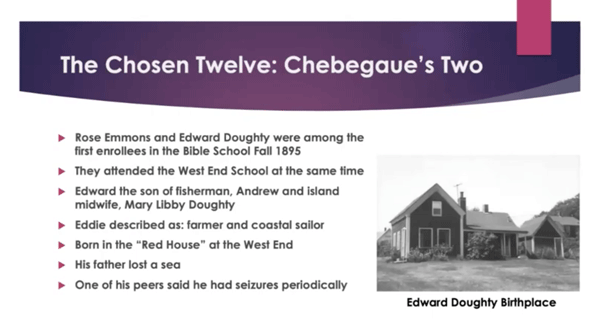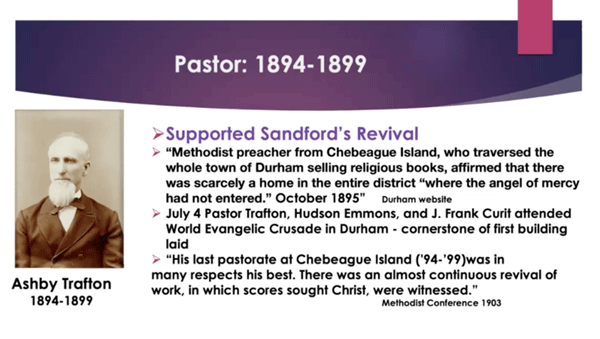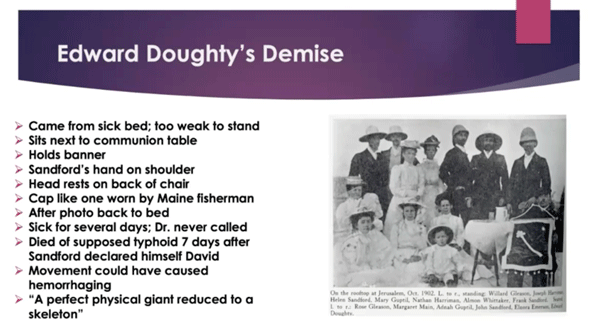He must have been charismatic. He must have been passionate. And he must have been persuasive. The open question is whether or not his faith was sincere.
The late 19th century was an era now known by religious scholars as the Third Great Awakening, a period when Christians expected the return of Christ. Frank Sandford, a preacher active during those years who drew followers from Chebeague Island and nearby Durham, according to a presentation by Chebeague historian Donna Damon, was influential, but reckless and dangerous.
Part of Damon’s online presentation—“A Charlatan, A Con Man, and a Saint—Religion on Chebeague, 1895-1905”—told the story of how Sanford (1862-1948) recruited residents to join his mission and perhaps was responsible for the death of an island resident. Not only did Sandford persuade some islanders and residents of nearby mainland communities to join his commune-like church, but the group traveled with him to the Middle East.
“They’d run out of food and Sandford would say, ‘OK, for 36 hours, nobody eats. God doesn’t want you to eat.’”
Sandford, a graduate of Bates College, lived in Durham, a town in Androscoggin County just west of Brunswick, and it was there that he hosted his first tent-meeting revival services. He launched his ministry announcing that he wanted to establish 100 “tents” and to recruit 100 evangelists, Damon said. Eventually, his charge to those evangelists was “to spread the word that he was Elijah and King David,” key figures in the Bible’s Old Testament.
“He advertised for 100 ministers and 100 singers because he figured music was a way to get through to people,” Damon explained. “I don’t know if they ever got 100.”

After establishing a “tent” in Durham, and eventually a temple there, which he dubbed Shiloh—part of which still stands, at 260-feet long and 40-feet wide—Sandford sought to site one on Chebeague Island.
In the late summer of 1895, the preacher took his “gospel boat,” as he called it, to the island. The tent there “drew islanders, night after night, to hear Frank Sandford,” Damon said. Ashby Trafton, the minister on Chebeague at the time, “may have been sympathetic to this cause,” she said.
By mid-October, Sandford had 18 converts on the island.
He told his followers they needed to sell 30% of their real estate, crops, and worldly goods. “Eventually, it became everything,” with their money going to fund Sandford’s work.
One follower, John Douglas, faked being sick so Sandford could “heal” him, she said, “because he was a wise guy,” and apparently thought it was a funny prank, but he later felt God had spoken to him and he joined the effort.

A local newspaper of the time, the Six Town Times, chronicled Sandford’s rise and reach and it, along with Shirley Nelson’s book Fair Clear and Terrible: The Story of Shiloh, Maine, were sources for Damon’s presentation.
“They’d run out of food [at Shiloh] and Sandford would say, ‘OK, for 36 hours, nobody eats. God doesn’t want you to eat.’”
Chebeague residents Hudson Emmons and J. Frank Curit attended the “World Evangelic Crusade,” as it was dubbed, in Durham. Other recruits from the island were Rose Emmons, “a pretty school teacher;” Edward Doughty, a farmer and coastal sailor; and Minnie Grannell Bennett. Bennett later told her family that “all she did was wash dishes,” Damon said.
Hudson Emmons, Rose’s father, “eventually decided he would sell all his worldly goods. He sold his house and moved up to Shiloh.” Emmons’ other daughter, Leona, joined them.
When the tent meeting shut down for winter, islanders were sad, she said, though Sandford did preach twice on the island in February, and just 90 minutes after one of the sermons, $10,000 was publicly pledged to his cause. But what followed in his ministry brought more than sadness.
“This is the part of the story that can be disturbing,” Damon warned.
Sandford formed a “chosen 12” group, six young men and six young women, to send out across the U.S. and the world. And a voyage to what was then Palestine—now Israel—was undertaken in 1902.
One of the chosen 12 declined to make the trip, and so Sandford took his 6-year-old son instead. Palestine was suffering with an outbreak of bubonic infection, and so the mission trip was diverted to Egypt.
Eddie Doughty defected during the voyage, Damon said, finding that Sanford’s claims of channeling David and Elijah was beyond reason. Sandford progressed from claiming to speak for the Old Testament men to claiming he and they were one and the same.
Doughty was convinced to return to the flock. Twice, he actually fell ill and Sandford was supposed to have cured him. But “Seven days after Sandford had declared himself David,” Doughty died, perhaps from typhoid.
“Some of the medical professionals were aghast when they found out the condition this guy was in,” she said, described as “a perfect physical giant reduced to a skeleton.”

Sandford wrote Doughty’s mother, Mary: “Your boy died gloriously.” Several years later, a young man told Mary that Sandford had poisoned Eddie.
Rose Emmons ended up staying in Jerusalem long enough to have three children there when the group finally made the intended destination.
In 1910, the ship the group was on wrecked off North Africa, Damon said, and they boarded another vessel which led to a “quiet mutiny,” with the group wanting to sail for Portland. But “God said to continue,” Sandford insisted. “God was sending him to Greenland, he said.”
When they did arrive in Portland, “people were horrified. Six sailors had died of scurvy,” the sails were in tatters, and Sandford was imprisoned, “but he continued to lead from there.”
Sandford had been convicted in 1904, implicated in the death of a 14-year-old boy, probably for starving him, but it was overturned by a court. He was convicted again on returning to Portland, and after being released, he moved to the Catskill Mountains area in New York and continued to be supported by followers.
“It disturbs me, thinking about it, even now,” Damon said. “It’s very sad.” She took comfort in finding a critical comment made by the Chebeague correspondent to the Six Town Times.
“So somebody on Chebeague had a half a brain. That made me feel better.”
Damon’s presentation is available for viewing at chebeague.org.
A recent Bangor Daily News story about Sandford’s trial can be read here.





